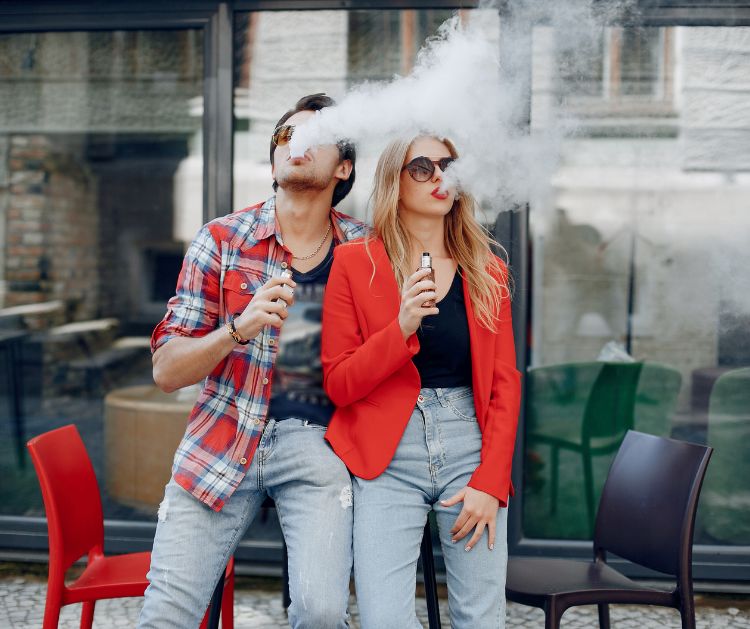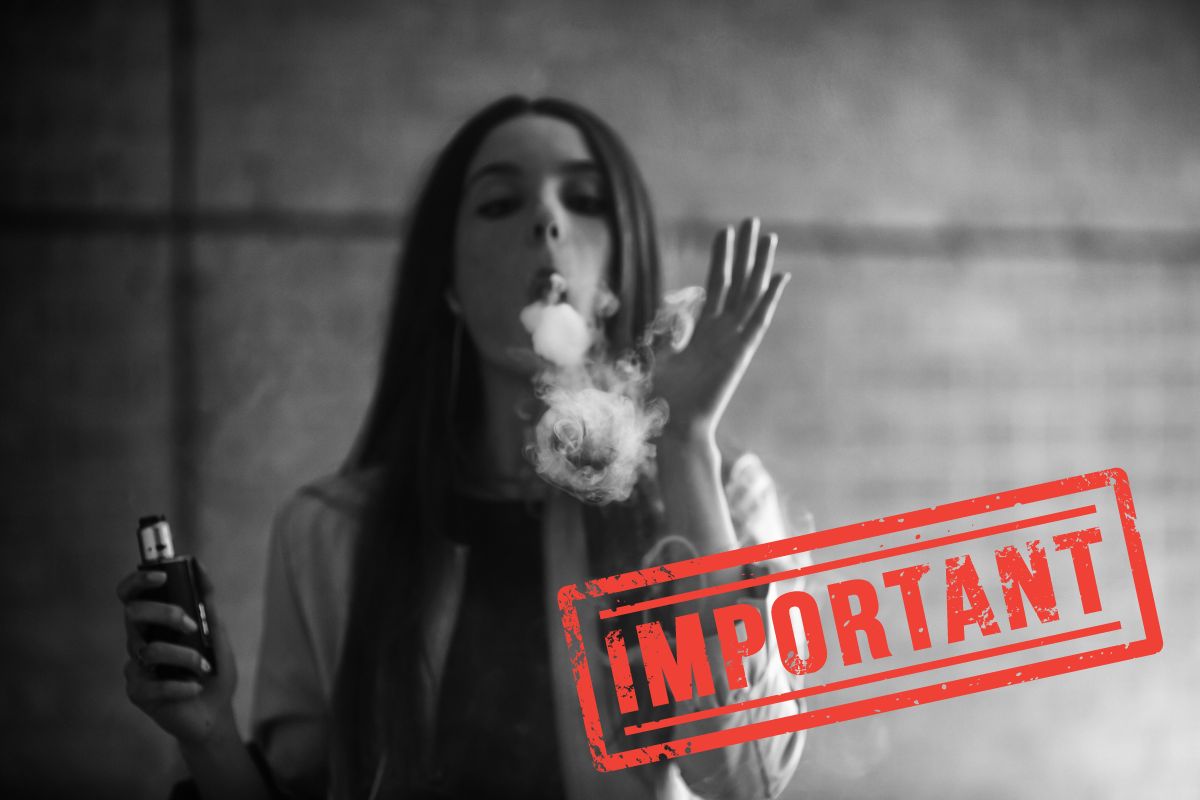
As you make your way across the bar, you get a whiff of smoke from somebody's vape pen that smells like bubblegum. The smoke fills the whole place. Since you are not the one smoking, I assume that this is a risk-free situation for you.
Even though the secondhand vape aerosol (the "smoke" from vaping) smells like candy, it is still dangerous to be exposed to it for even a short period of time, even if it is just for a few minutes.
How harmful is it?
The long-term health effects of secondhand vaping are yet unknown since the practice is still relatively new in the United States. Research on the long-term consequences of this practice is ongoing.
So far, we know that vape aerosol includes a variety of hazardous chemicals, including:
- nicotine
- ultrafine particles
- various other toxins, including several cancer-causing agents
It has been shown that nonsmokers who are exposed to secondhand vape aerosol have levels of nicotine absorption that are equivalent to those of nonsmokers who are exposed to secondhand cigarette smoke.
Non-smokers who are exposed to the nicotine and ultrafine particles found in secondhand vape aerosol may have an increased risk of developing cardiovascular disease.
The presence of additional carcinogens, such as those present in secondhand vape aerosol, raises the risk of developing certain cancers.
List of cancer-causing agents:
- lead
- formaldehyde
- toluene

Who’s most at risk?
Everybody is at danger from secondhand vape aerosol, although certain groups are more susceptible than others.
Infants and children
Because of their smaller size and still-developing respiratory systems, children and newborns are at particular danger from inhaling aerosol vapors.
The components of vape aerosol may have an impact on brain and lung development even at low quantities, according to a 2017 research.
Pregnant people
Tobacco use during pregnancy has been well-known for some time. This also applies to inhalation of nicotine aerosol from a vape pen.
According to a 2017 research, prenatal exposure to nicotine has been linked to a number of negative outcomes, including:
- preterm delivery
- low birth weight
- stillbirth
- impaired lung and brain development
- sudden infant death syndrome (SIDS)
People with lung conditions
Some of the flavorings in the aerosol that is generated by secondhand electronic cigarette use, such as diacetyl, have been linked to producing problems with the respiratory system.
Cilia are minute structures that resemble hair and line the interior of the airways. These structures are responsible for clearing the airways of mucus and debris so that you may breathe. A variety of chronic respiratory disorders, such as asthma and COPD, have been associated with a reduction in the activity of the cilia in the respiratory tract.
Those who are already suffering from a lung condition have an increased risk of developing asthma symptoms or perhaps having an asthma attack if they are exposed to the aerosol that is produced by secondhand vaping.
According to the findings of the 2018 Annual Asthma Survey, which was carried out by the Partnership between Asthma UK and the British Lung Foundation, vaping or exposure to secondhand vape was shown to be the cause of asthma symptoms in 14% of people who suffer from asthma.
Thirdhand exposure is a thing, too
When someone uses a vaporizer, the components of the aerosol settle on surfaces when they exhale. This occurs during the process of exhalation. This is referred to as "thirdhand smoke" (or aerosol).
You run the danger of coming into touch with these toxins whenever you make physical contact with a contaminated surface.

If you vape, keep these tips in mind
You can best protect yourself and others you care about from the harmful effects of your vaping by quitting. However, we understand that quitting isn't always possible for everyone.
To aid others, even if you aren't ready to give up, there are things you can do.
Do it outside
Use a vaporizer outside if you plan to vape. Avoid using e-cigarettes in your house or vehicle.
As a result, the air and surfaces within are free of the dangerous components, preventing others from inhaling or coming into touch with them on the surface.
Don’t vape around children or other high-risk people
Those who are pregnant, have allergies or lung diseases, or are infants or children are at greater risk of ill consequences from secondhand vape aerosol exposure.
Skip flavored vape juices
Vape juice flavoring chemicals have been linked to significant and long-term lung harm in persons who use the product.
Secondhand vape aerosol has also been shown to contain some of these substances.
Stick to low or no-nicotine vape products
When it comes to vaping, the health benefits received by all parties involved are directly proportional to the amount of nicotine present in the product.
If you're trying to quit smoking cigarettes by switching to vaping as an aid, a good rule of thumb is to cut down on your nicotine use gradually. If you entirely refrain from using nicotine, the likelihood that you and others around you will experience the negative consequences that are associated with nicotine will be diminished.
Choose a device with lower power and temperature
When it comes to the chemicals created and inhaled/exhaled, the vaping equipment you use matters.
Some vape juice constituents, such as formaldehydes, might produce new compounds when heated. The vapor may also include heavy metals from the heating coils, as well as other pollutants.
Toxic substances might be released into the air if you use items with greater power and temperature settings.
Other Conclusions
According to a study published online Jan. 10 in the journal Thorax, secondhand vapor exposure aggravated teenage bronchitis symptoms by 40% and shortness of breath by 53%.
People who did not vape or smoke were far more impacted. They were three times more likely to have bronchitis symptoms and twice as likely to have wheezing or shortness of breath, according to the study.
"Those people are suffering significantly more," Dr. Talat Islam, the primary researcher.
He is an assistant professor of population and public health sciences at the University of Southern California in Los Angeles.
"The effect of secondary exposure to vape was much bigger" among those who never vape or smoke.
According to Islam and his colleagues, the health effects of secondhand vapor are equivalent to those of secondhand smoking and should inspire more cities in the United States to outlaw vaping in public places.
According to the American Lung Association, e-cigarettes are now covered under indoor clean air rules in sixteen states and the District of Columbia. Overall, 28 states have passed comprehensive indoor clean air laws.
This study adds to the increasing body of evidence that e-cigarettes are not as safe as patients have been made to think, according to Dr. Laura Crotty Alexander, department chief of pulmonary critical care medicine at the VA San Diego Healthcare System.
"Despite the fact that there is no water in vape, some people believe it contains water-based aerosols. It's all chemicals, some of which resemble antifreeze." Alexander, who collaborated on the research's editorial, concurred.
"Typically, 50 to 100 chemicals are found in these e-cigarette aerosols, and your lungs don't appreciate that," she said. "It's bad for your lungs. It is toxic to the lungs and causes illness."
The bottom line
Even though secondhand vape may look harmless, don't be deceived by the delicious fragrances. Many of the same chemicals that have been linked to health problems in persons who use e-cigarettes may be found in the vapor that is exhaled when vaping.